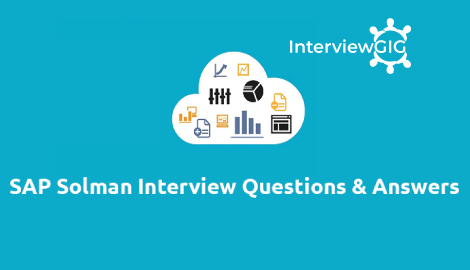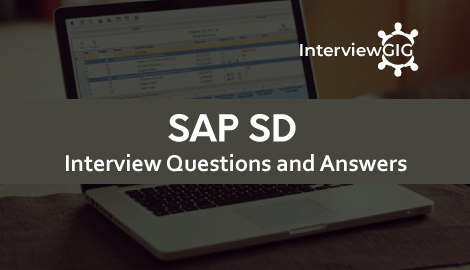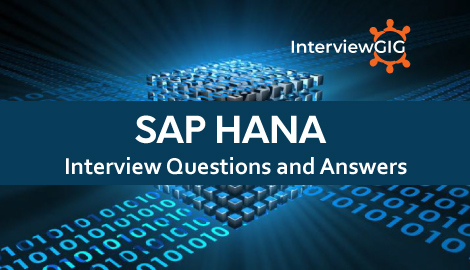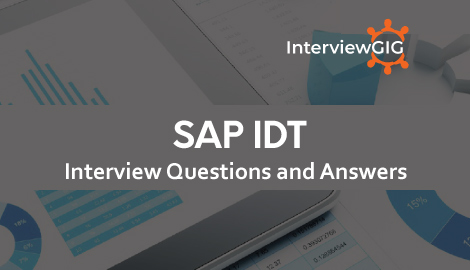SAP Basis Administrator Interview Questions
SAP Basis Administration is a critical role within the SAP ecosystem responsible for managing the technical infrastructure, ensuring the smooth functioning of SAP applications, and supporting various modules and components. Basis administrators are involved in system installation, configuration, monitoring, performance tuning, security, and overall system maintenance.
What are the key Roles and Responsibilities of SAP Basis Administrator?
The role of an SAP Basis Administrator is multifaceted, involving a wide range of responsibilities to ensure the smooth operation and performance of SAP systems.
Here are the key roles and responsibilities:
- System Installation and Configuration:
- Install and configure SAP systems, including database servers and application servers.
- Perform initial system setups and landscape planning.
- System Upgrades and Patch Management:
- Plan and execute system upgrades, applying patches and support packs.
- Ensure systems are up-to-date with the latest software versions and patches.
- Performance Monitoring and Optimization:
- Monitor system performance, identify bottlenecks, and optimize configurations.
- Conduct regular performance tuning to enhance system efficiency.
- User and Role Management:
- Manage user accounts and roles to ensure proper access control.
- Define and assign authorizations to users based on their roles.
- Backup and Recovery:
- Implement and maintain backup strategies to safeguard data integrity.
- Develop and test disaster recovery plans to ensure business continuity.
- Transport Management System (TMS):
- Configure and manage the TMS for transporting changes across system landscapes.
- Monitor and troubleshoot transport-related issues.
- Security Management:
- Implement and enforce security policies and best practices.
- Conduct regular security audits to identify and address vulnerabilities.
- System Monitoring and Alert Handling:
- Set up and maintain system monitoring tools to detect issues proactively.
- Respond to system alerts and address critical issues promptly.
- Database Administration:
- Administer and maintain the underlying databases (e.g., Oracle, SAP HANA).
- Optimize database performance and handle database-related issues.
- SAP Solution Manager Implementation:
- Implement and maintain SAP Solution Manager for system monitoring, issue management, and IT service management.
- Utilize Solution Manager functionalities for system documentation and reporting.
- SAP Landscape Planning:
- Plan and manage SAP landscapes, including development, testing, and production environments.
- Coordinate system copies, refreshes, and landscape changes.
- Automation and Scripting:
- Develop and use scripts or automation tools for repetitive tasks.
- Implement configuration management tools for efficient system administration.
- Collaboration with Other Teams:
- Collaborate with SAP functional teams, developers, and infrastructure teams.
- Provide technical support and expertise to other IT teams.
- Up-to-Date Knowledge:
- Stay current with SAP technologies, updates, and best practices.
- Participate in training and certification programs to enhance skills.
- Documentation:
- Maintain comprehensive documentation for configurations, procedures, and troubleshooting steps.
- Ensure that knowledge is well-documented and shared within the team.
- Disaster Recovery Planning:
- Develop and maintain disaster recovery plans to minimize downtime.
- Conduct regular testing of disaster recovery procedures.
- SAP Security Compliance:
- Ensure compliance with SAP security standards and industry regulations.
- Participate in audits and address compliance-related concerns.
What is the current version of SAP GUI? How do you install it?
The current version of SAP GUI for Windows is 7.70, released in February 2023. However, it’s important to note that downloading and installing SAP GUI directly is not recommended for most users due to the following reasons:
- Security concerns: Downloading from unauthorized sources can expose your system to security risks like malware or unauthorized access.
- Version control: Your organization likely has specific security protocols and version control procedures in place, and installing software outside those procedures can compromise system integrity.
- Licensing restrictions: SAP GUI is typically licensed and deployed by IT departments within organizations, ensuring proper licensing compliance and configuration.
Explain the architecture of SAP system with different layers. What is the use of Gateway?
- Presentation layer communicates with the application server to perform all the processing. This is known as the brain of a SAP system.
- An application server consists of multiple instances and communicates with the database layer of the three-tier architecture.
- Bottom layer is called the database layer. This is responsible to store all the data. Database of SAP system is kept on a separate server for performance and security reason.
- The Presentation layer consists of different components for ABAP and JAVA that enables the communication and processing of data in SAP system. The key components at Presentation layer also includes — Gateway. This is used to manage communication between SAP system and external systems.
Suppose you have to integrate SAP ECC (current version) to AWS cloud. How can you achieve this?
Integrating SAP ECC (current) with AWS involves several options:
- Lift & Shift: Simplest but may not be cost-effective in the long term.
- Hybrid Integration: Combines on-premise ECC with specific AWS services.
- S/4HANA Conversion & Cloud Migration: Most complex but offers performance and functionality benefits.
Key steps (considering S/4HANA and cloud migration):
- Plan & assess: Analyze current ECC, identify cloud use cases, and assess dependencies.
- Proof of Concept (POC): Test chosen methods in a small-scale AWS environment.
- System preparation: Optimize ECC for migration (data, security, compatibility).
- Migration & configuration: Move data and system to AWS, configure connections.
- Testing & validation: Ensure smooth operation and data integrity.
- Ongoing management: Monitor performance, optimize resources, and maintain security.
How do you check the installed software components and product versions on SAP system?
Go to SAP system data → Click on component magnifying glass.
The following two options will be displayed :
- Installed Software Component Versions
- Installed Product Versions
- Under installed software component, you can see all the software installed, support package, service pack, description etc. If you want to check the details of each component, you can select the component and go to the details tab as shown above.
- Go to Installed Product Versions; it will show you the version of the installed SAP NetWeaver.
What is client administration in SAP system? Why do we use multiple clients in SAP system?
A client is used in SAP system for multiple login on a single instance. You can create multiple clients on a single instance. It also provides data security as one user with one client can’t see the data of the other user with another client and also there is no need to install the software again.
The following are the advantages of client administration in SAP system :
- Using SAP Clients, the same resources can be shared between multiple users.
- It helps you to manage SAP system landscape as you can create multiple clients for DEV, QA and PROD team.
- It allows you to share the SAP system with a large number of users.
- We have standard clients in SAP system
What are the different user types in SAP system that an admin can use while creating a new user?
The following are the five different typ”]es of user types :
Dialog user : This user is used for interactive system access from GUI.
System user —:This user is used for background processing and communication within a system.
Communication user : This user is used for external RFC calls.
Service user —:This user is created for a larger and anonymous group of users.
Reference user : These are reference users with no logon possible, non-person related users that allow the assignment of additional authorizations.
How can you define login policy for users in SAP system?
You can set the number of incorrect login attempts and then system can end the session or can also lock the user account if parameter value is set by Administrator. There are two types of parameters used −
Static : This parameter doesn’t apply immediately and the system needs a Restart for this.
Dynamic −:This parameter can be applied directly and the system does not need a Restart.
To set the value of parameters, use transaction code — RZ11s
What are the different login and password parameters that can be applied in SAP system?
To set the number of failed attempts, use parameter — login/fails_to_session_end.
Likewise, you have other parameters such as login/fails_to_session_end, login/fails_to_user_lock
The following are the password policy parameters −
- login/min_password_lng
- login/password_expiration_time
What are the categories to execute SAP Background jobs?
Class A (High Priority) : This is used for urgent or critical tasks. These tasks must be scheduled with class A priority job. Class A: job reserves one or more background work processes.
B (Medium Priority) : These are executed after the completion of Class A high priority jobs.
C (Low Priority) : These jobs run once class A and class B jobs are completed.
What are the different options available for scheduling a background job? What start conditions type can be used?
To schedule a background job you must specify the conditions that will trigger the job to start.
The different types of start condition you want to use are −
- Immediate
- Date/Time
- After Job
- After Event
- At Operation Mode
What are the different types of job status? Can you unschedule an active job?
The different types of status are – Scheduled, Released, Ready, Active, Finished, Cancelled
You can’t unschedule a job if it is active. You need to wait for the completion of the job to unscheduled it.
What is the use of commit value while deleting jobs in SAP system?
Commit value is proportional to program performance. If the commit value is high, then job deletion will run faster. Recommended value is >= 1000.
Which transport directory is used to implement support package and add-ons?
Transport directory /usr/sap/trans should have enough space.
What is the use of Kernel in SAP system? How do you check the current Kernel version in SAP system?
Kernel is an executable program that exists between SAP Applications and operating system. It consists of executable program under the path — “/sapmnt/<SID>/exe” for UNIX and \usr\sap\SID\SYS\exe\run Windows. It starts and stops application services such as message server, dispatcher, etc.
In Kernel upgrade, new .exec files replace old executable files in SAP system. To check the current version, use Transaction SM51 and go to Release Notes.
To check the status, go to System → Status tab → Other Kernel info
What are the key activities that you perform as part of SAP Basis support?
- Job Processing and Scheduling
- User Management
- SAP system configuration and Client Administration
- Installation and Patch Upgrade
- Installation and Patch Upgrade
- Managing interfaces and integration with servers
How do you check the users logs in your system and how many sessions each user is generating?
SM04: To check number of users are logged into the system and in which client and how many session each user is generated and in each session what transaction is being executed.
[dt_sc_toggle title=”How do you maintain roles in SAP system?
PFCG: This is used to maintain roles in SAP system.
What is SAP GUI?
SAP GUI is known as client tool which is used to access remote central server and runs on different operating systems like Microsoft Windows, UNIX, Mac, etc. This is used to manage and access SAP applications like SAP ECC and SAP Business Intelligence system.
Do you know the different supported platforms for SAP GUI?
- Windows environment
- Java(TM) environment
- HTML / Internet Transaction Server (ITS)
Are you aware of Blue Crystal design of SAP GUI?
SAP Blue Crystal is a new visual design theme which succeeds Corbu. It provides a consistent design that allows users to seamlessly experience SAP GUI and NWBC elements. It is the standard theme of Fiori applications and comes with a new color palette and icons which are better scalable.
What is SAP Market place?
To download SAP Products. Service.sap.com to login to SAP Market Place
”What
How do you create an instance?
To create an instance, you should first define an operation mode. To create an instance, go to CCMS > Configuration or use Transaction code RZ04.
Where do you download trail version of SAP ECC, what is SAP CAL?
You can download SAP ECC 6.0 free trial from SAP Market place. It is also possible to integrate SAP ECC 6.0 trial using SAP Cloud Appliance Library ACL to AWS or other cloud environment service provider by providing user public cloud key.
What is SAP NetWeaver?
SAP NetWeaver is known as open technology software component that provides you a platform to run critical business applications and integration between people, processes and information. It allows the composition, provisioning, and management of SAP and non-SAP applications across a heterogeneous software environment.
What is SAP NetWeaver Administrator tool?
SAP NetWeaver Administrator (NWA) is a Web-based tool that allows you to perform configuration, advanced administration, monitoring, troubleshooting, and diagnosing a SAP NetWeaver system.
You can use NWA tool in these working modes :
What do you understand by SAP Client administration?
A client is used in SAP system for multiple login on single instance. You can create multiple clients on a single instance. It also provides data security as one user will client can’t see data of other user and also there is no need to install the software again.
When your database size is large, how you can perform client copy in SAP landscape?
It is always recommended to use import/export option for client copy when database size is large.
Steps to export a client − Log on to Target system and create an entry for new target client using Transaction SCC4. To perform export for transferring data files to target system import buffer use Transaction SCC8.
What is password policy?
It is also possible to define password policy for users in SAP system. This includes :
- User has to set minimum password length
- Password expire policy
- Password complexity, etc.
What do you understand by executing background jobs in SAP system?
Background jobs are jobs in SAP system that run in the background without effecting normal operations in the system. Background jobs are used to reduce manual effort and to automate the process. They can run in the background without any user input and can be scheduled to run when system load is low.
What do you understand by Transport Management in SAP Basis?
TMS is one of the key component in SAP system and used to control the new requests, to monitor the changes- who has implemented the changes, defining and configuring system landscape in SAP environment.
Where do you check Transport request logs?
You can also check the logs once the transport request is completed. To check the logs, Transaction SE01 → GoTo → Transport Logs.
What is the use of Patches in SAP system? Could you name few common patch types?
In SAP system, when a bug is found you have to use patches to fix the bug. There are different types of patches that can be used in SAP system. All patches start with SAPK followed by patch type.
- ABAP (SAPKA620XXXX)
- (SAPKA620XXXX)
- (SAPKA620XXXX)
- (SAPKA620XXXX)
What is RFC connection?
To communicate between SAP systems, there is a need to define a mechanism. One of the most common way is to define Remote function Call RFC connection between two systems. By creating a trusted RFC connection between two, it allows you to create trusted-trusting relationship between systems and you can communicate and exchange information and data.
Top 10 Most Asked SAP BASIS Admin Interview Questions and Answers
Question: What is the concept of SAP Intelligent Enterprise (IE) and how it impacts Basis administration.
Answer: SAP Intelligent Enterprise refers to an integrated suite of solutions that leverages advanced technologies like AI, ML, and IoT to enable intelligent business processes.
Impact on Basis: Basis administrators play a crucial role in supporting IE by ensuring seamless integration, managing automation tools, and maintaining the underlying infrastructure. Automation reduces manual efforts, integration supports cohesive processes, and AI/ML tools demand efficient system management.
Question: What is your experience with migrating SAP systems to the cloud (e.g., using SAP HANA Enterprise Cloud or AWS)?
Answer: I have successfully led the migration of SAP systems to the cloud, including projects involving SAP HANA Enterprise Cloud and AWS. This includes planning, executing, and optimizing the migration, ensuring minimal downtime and maximizing performance.
Question: How do you stay updated on the latest SAP Basis security patches and vulnerabilities?
Answer: I regularly monitor SAP’s security channels, subscribe to security newsletters, and participate in SAP forums and community discussions. This proactive approach helps me stay informed about the latest security patches, vulnerabilities, and recommended best practices.
Question: What is the role of SAP Solution Manager 7.2 (SolMan 7.2) in system monitoring and problem management for a Basis Administrator?
Answer: SolMan 7.2 serves as a central hub for system monitoring, issue management, and IT service management. Basis administrators utilize SolMan for proactive monitoring, early detection of issues, and streamlined problem resolution. It plays a crucial role in maintaining system health and ensuring optimal performance.
Question: Describe your approach to automating SAP Basis tasks using tools like scripts or configuration management tools (e.g., Ansible)?
Answer: I leverage Ansible for automation, creating playbooks for routine tasks, such as system configuration and patching. Automation enhances efficiency, reduces errors, and allows for better scalability. This approach ensures consistent and reliable system management.
Question: what is the concept of a High Availability (HA) cluster environment for SAP and how you would manage it?
Answer: An HA cluster environment involves multiple servers working together to ensure continuous availability. In SAP, this minimizes downtime and enhances reliability.
Basis administrators are responsible for configuring, monitoring, and maintaining HA clusters. This includes failover testing, ensuring data consistency, and implementing disaster recovery plans.
Question: How do you handle system performance issues and bottlenecks in an SAP environment?
Answer: I follow a proactive approach by monitoring system performance metrics, identifying bottlenecks, and optimizing configurations. Techniques include workload analysis, buffer tuning, and optimizing SQL queries. Regular performance testing and tuning are essential for maintaining optimal SAP system performance.
Question: What is your experience with SAP Basis security best practices, such as user authorization management and access control.
Answer: I have implemented and managed SAP security best practices, including user authorization management and access control. This involves defining roles and authorizations, regularly reviewing and adjusting permissions, and ensuring compliance with security standards.
Question: What is the role of SAP Basis in implementing SAP S/4HANA and the specific challenges involved.
Answer: Basis administrators play a critical role in S/4HANA migration by ensuring system readiness, performing technical upgrades, and handling data migration. Challenges include adapting to the new data model, managing Fiori apps, and optimizing performance for the in-memory computing of HANA.
Question: Discuss your thoughts on the future of SAP Basis administration in the context of emerging technologies like artificial intelligence (AI) and blockchain
Answer: The future of SAP Basis is closely tied to embracing emerging technologies. Basis administrators will increasingly need skills in managing AI-driven applications, blockchain integration, and advanced analytics. Continuous learning and adapting to evolving technological landscapes will be key in ensuring the relevance and effectiveness of SAP Basis administration.





